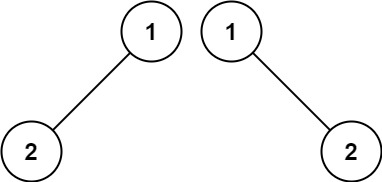Given the roots of two binary trees p and q, write a function to check if they are the same or not.
Two binary trees are considered the same if they are structurally identical, and the nodes have the same value.
Example 1:

Input: p = [1,2,3], q = [1,2,3] Output: true
Example 2:

Input: p = [1,2], q = [1,null,2] Output: false
Example 3:

Input: p = [1,2,1], q = [1,1,2] Output: false
Constraints:
- The number of nodes in both trees is in the range
[0, 100]. -104 <= Node.val <= 104
Approach 01:
-
C++
-
Python
#include <bits/stdc++.h>
using namespace std;
struct TreeNode {
int val;
TreeNode *left;
TreeNode *right;
TreeNode() : val(0), left(nullptr), right(nullptr) {}
TreeNode(int x) : val(x), left(nullptr), right(nullptr) {}
TreeNode(int x, TreeNode *left, TreeNode *right) : val(x), left(left), right(right) {}
};
class Solution {
public:
bool isSameTree(TreeNode *p, TreeNode *q) {
if (p == nullptr && q == nullptr)
return true;
if (p == nullptr || q == nullptr)
return false;
if (p->val != q->val)
return false;
return isSameTree(p->left, q->left) && isSameTree(p->right, q->right);
}
};
from typing import *
class TreeNode:
def __init__(self, val=0, left=None, right=None):
self.val = val
self.left = left
self.right = right
class Solution:
def isSameTree(self, p: Optional[TreeNode], q: Optional[TreeNode]) -> bool:
if(p is None and q is None):
return True
if(p is None or q is None):
return False
if(p.val != q.val):
return False
result = self.isSameTree(p.left, q.left) and self.isSameTree(p.right, q.right)
return result
Time Complexity
- Recursive Traversal:
The function
isSameTreeperforms a recursive traversal of both trees. In the worst case, every node in both trees needs to be compared once. - Overall Time Complexity:
The overall time complexity is \( O(n) \), where \( n \) is the number of nodes in the smaller of the two trees.
Space Complexity
- Recursive Stack Space:
The space complexity is determined by the maximum depth of the recursion stack. In the worst case, this depth is equal to the height of the tree.
- Overall Space Complexity:
The overall space complexity is \( O(h) \), where \( h \) is the height of the tree. In the worst case, for a completely unbalanced tree, this can be \( O(n) \). For a balanced tree, the space complexity will be \( O(\log n) \).